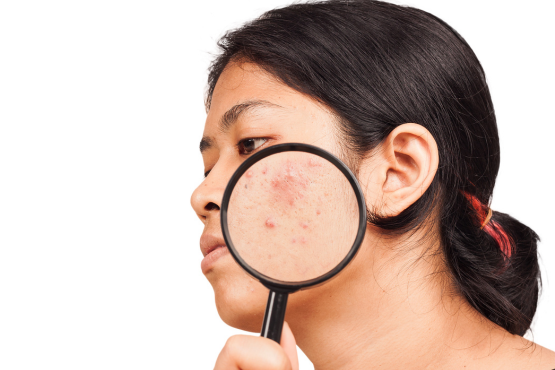Beautiful and healthy skin is a cherished asset, and many individuals strive to maintain its flawless appearance. Unfortunately, one common skin concern that plagues both men and women is the presence of black spots on the face. These spots, often referred to as hyperpigmentation, can cause self-consciousness and frustration.
In this blog post, we will explore the nature of black spots on the face, their causes, and most importantly, whether they are permanent or not. So, let's dive in and debunk the myth surrounding these pesky dark spots.
Understanding Hyperpigmentation
Before we delve into the permanence of black spots on the face, it is crucial to understand what causes them. Hyperpigmentation occurs when the skin produces excess melanin, the pigment responsible for giving color to our hair, skin, and eyes. There are various types of hyperpigmentation, including melasma, post-inflammatory hyperpigmentation (PIH), and sunspots.
Melasma is often triggered by hormonal changes, such as pregnancy or birth control pills, while PIH results from skin trauma, such as acne or injury. Sunspots, as the name implies, are a consequence of prolonged exposure to the sun's harmful UV rays.
Permanence of Black Spots
Now, let's address the pressing question: are black spots on the face permanent? The answer is both yes and no, depending on the type of hyperpigmentation. While some forms of hyperpigmentation can fade over time or with proper treatment, others may require more extensive measures to achieve satisfactory results.
Melasma: Melasma can be persistent and challenging to treat. While it may lighten on its own after the triggering factors subside, it often requires a combination of treatments such as topical creams, chemical peels, and laser therapy. Consistent and diligent adherence to these treatment regimens is crucial for effective results.
Post-Inflammatory Hyperpigmentation (PIH): Unlike melasma, PIH has a higher chance of fading over time. Once the underlying cause, such as acne or injury, is resolved, PIH tends to improve gradually. Additionally, treatments such as topical creams containing ingredients, like probiotic actives, BRIGHT Oléoactif®, and vitamin C, can expedite the fading process.
Sunspots: Sunspots, also known as age spots or liver spots, can fade with time and proper sun protection. The use of broad-spectrum sunscreen with a high SPF, along with sun-protective clothing and accessories, can prevent further darkening of the spots and allow the skin to heal and rejuvenate naturally.
Prevention and Treatment
While the permanence of black spots on the face may vary, prevention and treatment strategies can help manage and minimize their appearance.
Sun Protection: Shielding your skin from the sun's harmful rays is crucial in preventing and reducing hyperpigmentation. Regularly apply a broad-spectrum sunscreen with a minimum SPF of 30, wear protective clothing, and seek shade during peak sun hours.
Skin Care: Establishing a proper skincare routine can contribute to the overall health and appearance of your skin. Use gentle cleansers, moisturizers, and exfoliants suitable for your skin type. Incorporate products containing ingredients like vitamin C, niacinamide, or BRIGHT Oléoactif® that can help fade dark spots over time.
Professional Treatments: If over-the-counter remedies prove ineffective, consider consulting a dermatologist or a skincare professional. They can recommend targeted treatments such as chemical peels, microdermabrasion, laser therapy, or prescription-strength creams.
Topical Treatments: Over-the-counter creams and serums formulated to target hyperpigmentation can be an effective starting point. Look for ingredients like vitamin C, BRIGHT Oléoactif®, bakuchiol, raspberries & papaya extracts, or licorice extract, which have been shown to inhibit melanin production and promote skin lightening. Remember to follow the instructions carefully and be patient, as results may take several weeks or months to become noticeable.
Chemical Peels: Chemical peels involve the application of a chemical solution to the skin, which exfoliates the top layer and encourages the growth of new, healthier skin cells. Depending on the severity of the hyperpigmentation, different types of peels, such as alpha hydroxy acid (AHA) peels or trichloroacetic acid (TCA) peels, may be recommended. Multiple sessions may be necessary to achieve desired results.
Laser Therapy: Laser treatments, such as Intense Pulsed Light (IPL) or fractional laser resurfacing, can target and break down excess melanin in the skin. These procedures are performed by dermatologists or trained professionals and may require several sessions spaced apart for optimal results. Laser therapy can be particularly effective for stubborn or deep-seated hyperpigmentation.
Conclusion
In conclusion, the permanence of black spots on the face, or hyperpigmentation, depends on the specific type and underlying causes. While some forms, like melasma, can be more challenging to treat and may require ongoing management, others, such as post-inflammatory hyperpigmentation or sunspots, have a higher chance of fading over time with proper care and treatment.
Prevention through sun protection and a consistent skincare routine is key to managing and minimizing the appearance of black spots. If hyperpigmentation persists or causes significant distress, it is advisable to seek professional advice from a dermatologist or skincare specialist for tailored treatment options.
Remember, patience and consistency are vital in achieving clearer, more radiant skin.



